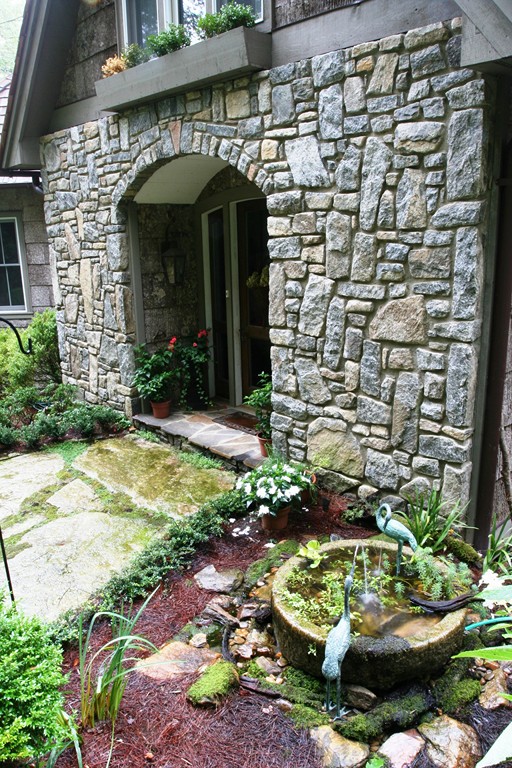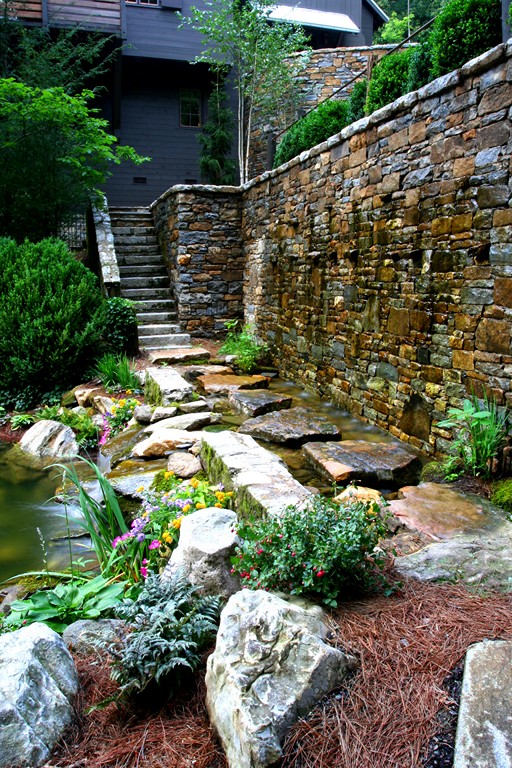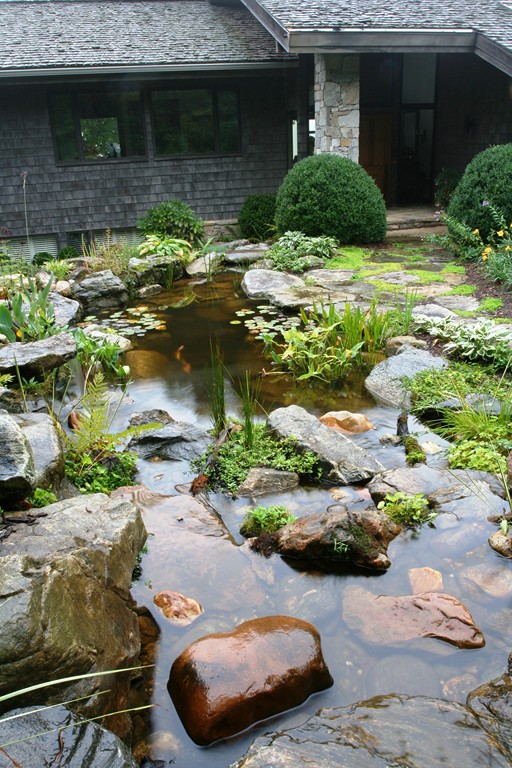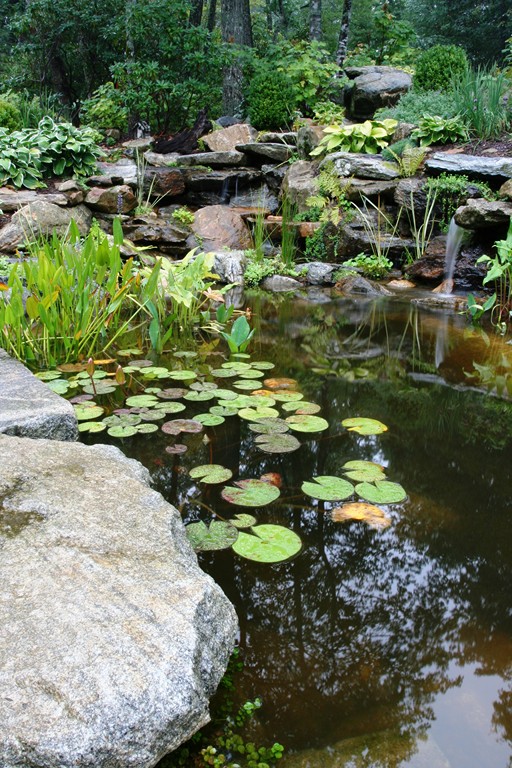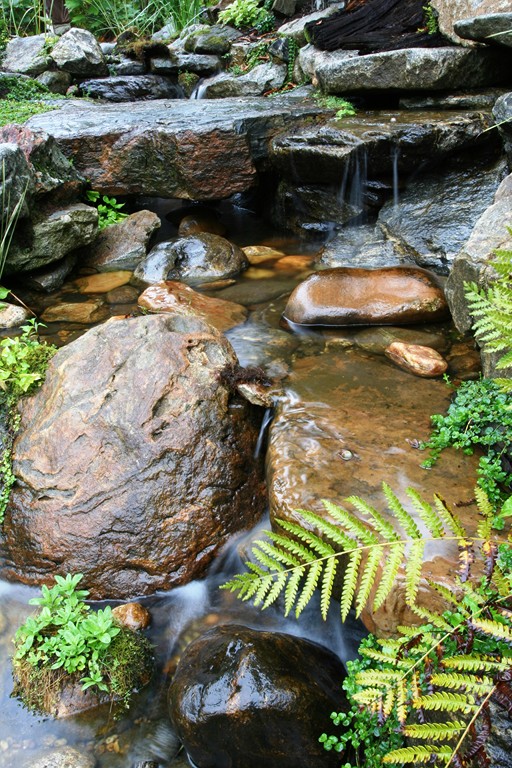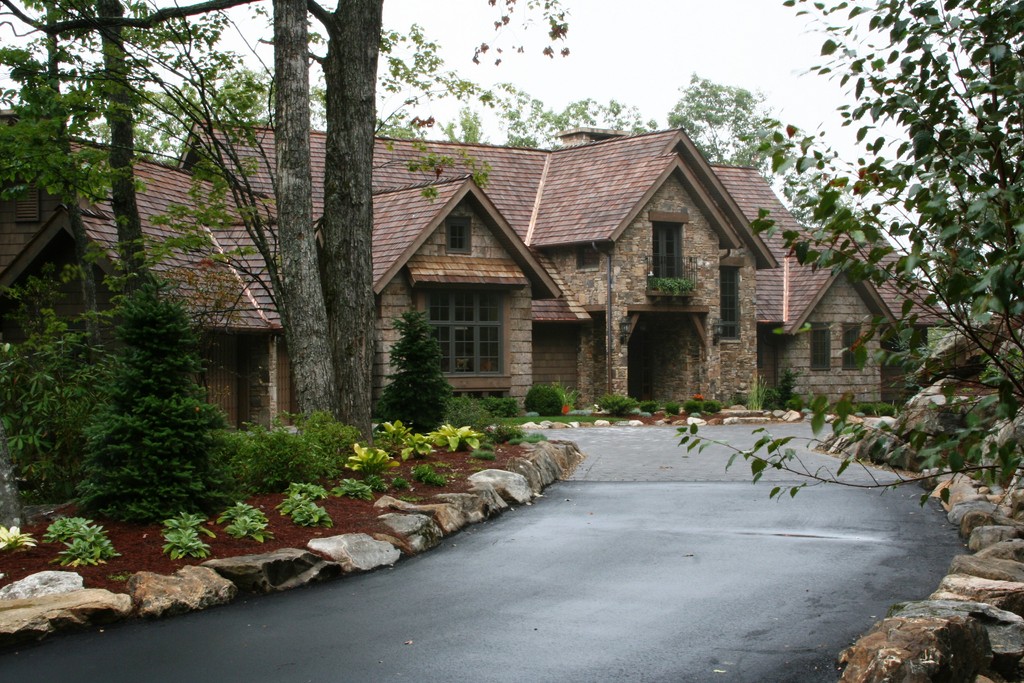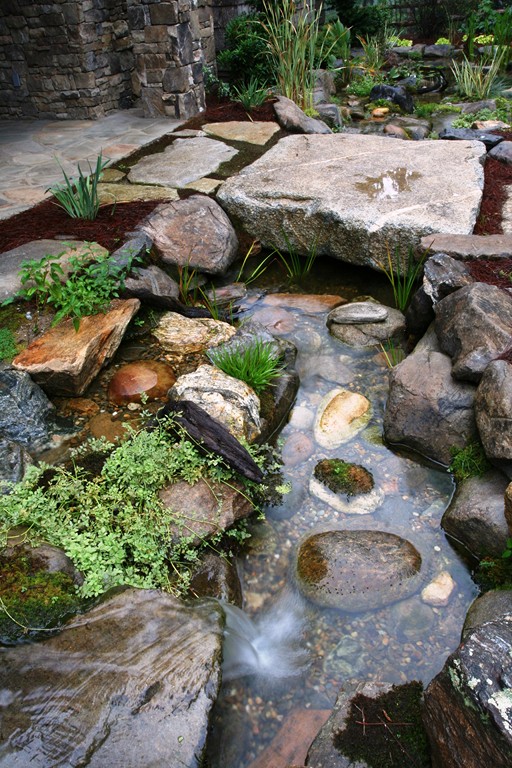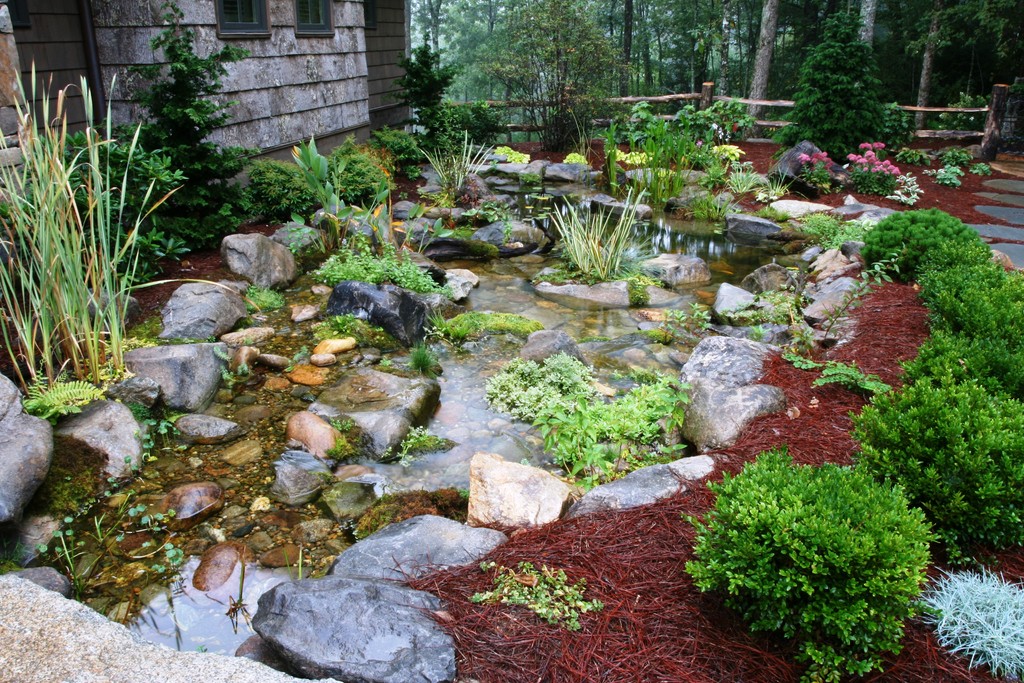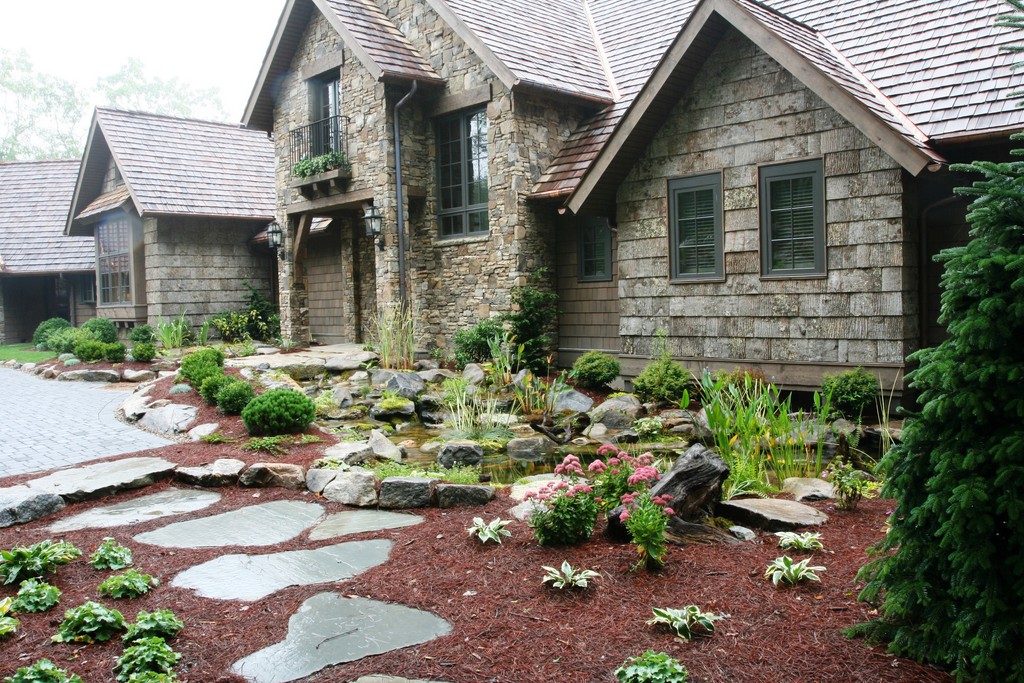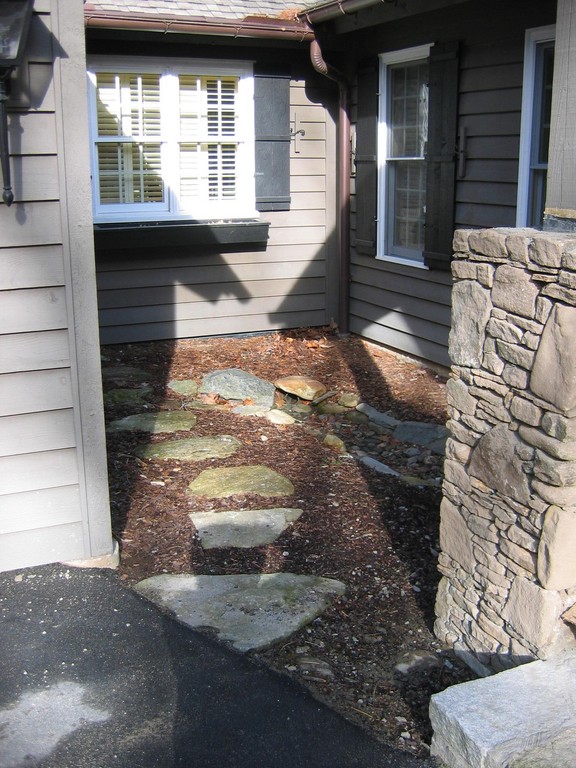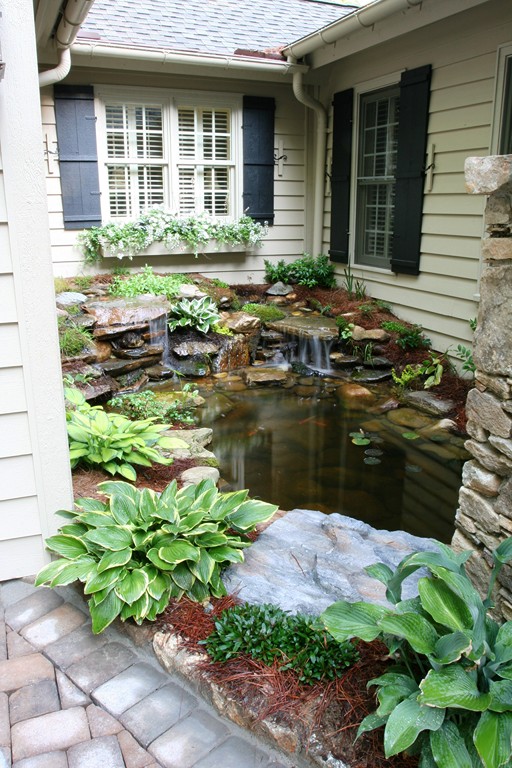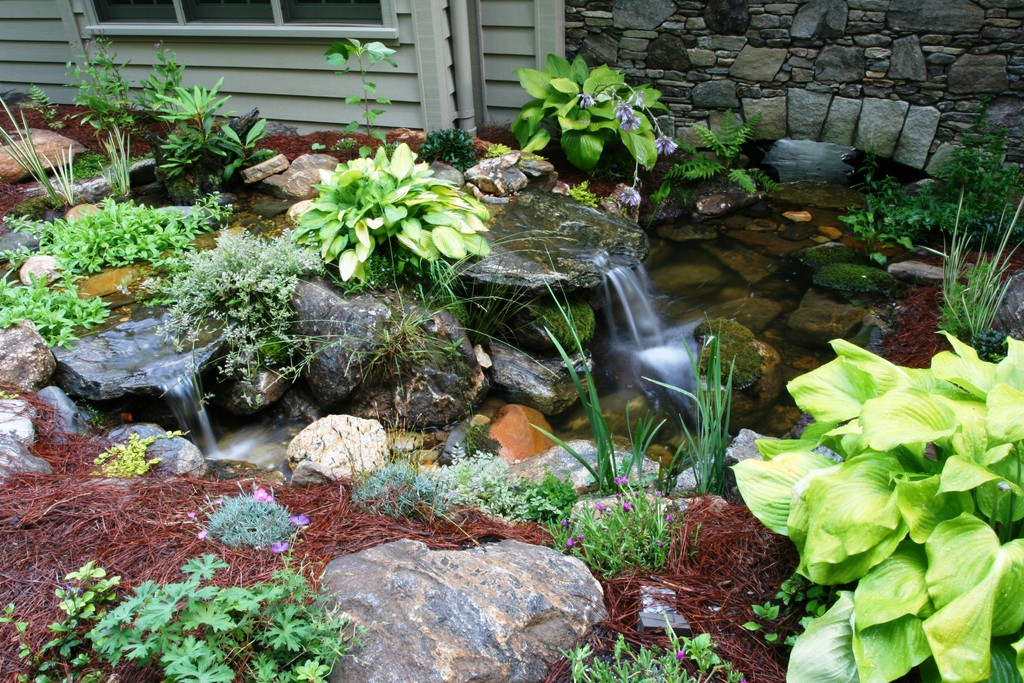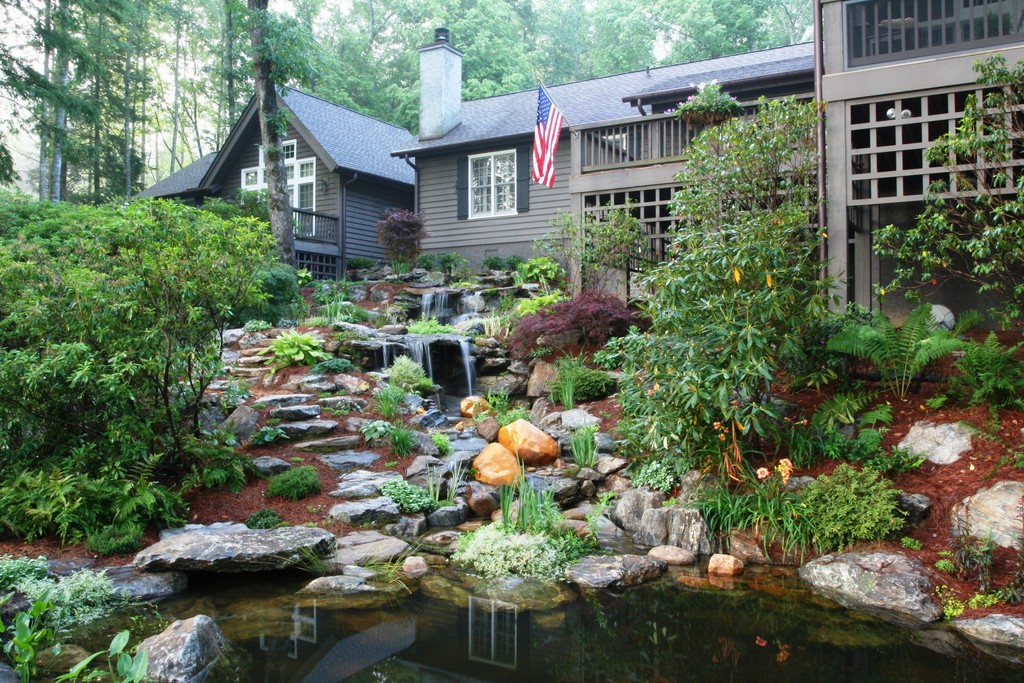Welcoming Waters

For a long time, we’ve focused on creating highly naturalistic ponds, cascades and streams that fit seamlessly into the wooded landscapes of North Carolina – projects of such quality that they stand up well in comparison to the vast numbers of natural watershapes we see just about every time we turn around.
Until recently, the overwhelming majority of these watershapes were installed in backyards, away from public view, with many of them situated on these properties in ways that removed them from immediate access or turned them into remote destinations.
That preference among our clients at Xstream Ponds (Cashiers, N.C.) seems to be changing. In the past few years, in fact, we’ve noticed a significant increase in the number of homeowners who want some kind of watershape installed in their front yards – someplace close to their homes’ main entrances. The basic idea: They want the water to become an integral part of their homes’ architecture rather than a separate backyard destination.
We have an advantage of working in a part of North Carolina where the homes feature a distinctly rugged, rustic style that looks comfortable in the presence of woods and water. These residences serve as perfect canvasses for our projects no matter where we place them. In the case of ponds and streams in the fronts of homes, however, this new demand gives us unusual opportunities to create the illusion that the water was there first and that the homes were built right up to its edges.
THE HOME FRONT
In tackling these front-yard projects, we know we must clear a high bar when it comes to making things seem completely natural.
Indeed, given the up-close visibility of entryway installations, there’s no room at all for revealing our human handiwork. And while there are similarities between what we’ve long done out back and what we’re now doing up front, we’ve actually come to see this street-side work as a new genre and a fresh opportunity for us to use water to enhance our clients’ daily lives.
As many times as it’s been written in these pages, it bears repeating: There’s something about the presence of water that resonates with the human spirit and psyche. And when those bodies of water successfully bring the subtlety and complexity of nature right up to and even into the home, those emotional connections can be surprisingly powerful.
When you situate water adjacent to a home’s entry, those connections are renewed each and every time someone arrives or departs. Instead of confronting an expanse of lawn divided by a utilitarian path to the front door, the resident of (or visitor to) a home with a front-yard watershape is welcomed by the sights and sounds of reflective or moving water – not to mention the rocks, plants and fish that give the watershape its deeper, rustic character.
| Our front-yard/entryway projects have a fantastic range, from the very modest to the highly elaborate and architectural. Whichever way it works out, our focus is on making the process of coming and going one to remember – the sort of experience homeowners and their visitors won’t have any objection to repeating over and over again. |
Personally, I can’t think of a better greeting at the end of hard day’s work – or a more perfect way to set myself up for a great day. Outside our homes, the world has become a speedy, stressful and even threatening place, turning the spaces we occupy into sanctuaries from traffic, worries, pressures and everything else we experience while we’re away. Coming or going, a well-conceived watershape creates a physical and psychological buffer that causes residents and visitors alike to slow down, take notice and catch a deep, refreshing breath.
And if the water is visible from the street (which is usually the case in our projects), even passersby have a chance to pause and take in the scene whether walking or driving by. It becomes a signature – a subtle yet powerful statement about the character of the home and, by association, the people who live there.
I don’t know about you, but it’s tough for me to feel cynical about a home (or the people in it) when the scene out front is defined by a beautiful body of water. It all just seems so neighborly, so friendly, so down-to-earth!
UNEXPECTED PEACE
What’s interesting about all this is that, to a person so far, our clients don’t seem to anticipate all the joys and benefits that await them when they call us in to install a watershape in the front yard.
Yes, they have a rational attraction to the idea of beautifying their homes – and in most cases have seen some of our work, which seems most directly to have inspired them to seek out the beauty that only these watershapes can provide. But when I tell them just how much they’re going to appreciate having water at their front entrance, it’s clear to me that they think I’m overstating the case and am simply putting on a hard sell.
That doesn’t bother me in the least, because experience has shown me that, without fail, when our clients begin living with their front-yard watershapes and come to appreciate just how much they increase the satisfaction of home ownership, they invariably come back and tell me just how right I was and how happy they are. Sure, that happens with backyard waterfeatures, too, but the joy increases manifold times with front-yard installations simply because clients are exposed to them with far greater regularity.
I take it as an encouraging sign, moreover, that our front-yard installations are almost always better maintained by homeowners than are those located in back corners of their properties. That may be entirely due to the fact that these front-entry features are much more frequently seen – perhaps several times each day – and that, as a result, our clients become more attuned to their rhythms and needs and are aware of what it takes to keep the water looking great and the fish and plants in good health.
| These watershapes are meant to be seen at very close range on a more or less continuous basis. This puts a premium on finishing them with details that provide immediate, familiar visual delight as well as infusing them with fish and plants that give the setting a sense of constant change, growth and variety no matter the season or the time of day. |
I also find encouragement in the fact that we’re getting lots of inquiries – some of them quite adamant – from prospects who want us to tell them what we can do with their entryways. As is the additional case with many watershaping firms, our work comes by way of referrals, and the fact that people are coming to us with such keen interest in how we can transform their front yards tells me that this is more than a passing fad.
As a businessperson, I see an additional benefit in the fact that these watershapes aren’t hidden away in backyards where nobody other than family and friends can see them. These watershapes are creating a strong, additive demand where there was not much before. Indeed, to us an industry analogy we can all understand, I’ve come to see these projects as self-priming pumps and the placement of water out in the open in front of homes as a win-win situation for everyone involved.
KEY CONCERNS
As I suggested above, the real work of watershaping in front yards is not substantially different from what we do in backyards: All the same principles apply as we layer the experience, focus on edge treatments, create believable vertical transitions, compose beautiful subsurface rockscapes, establish hospitable environments for fish and fuse stones and plants into the surrounding landscape. That’s always true no matter where our bodies of water are situated.
As I also suggested, however, this new genre involves some design characteristics and challenges that set it apart from other types of work.
For starters, you need to consider that the water is part of a well-traveled thoroughfare. The upshot of this observation is that we generally establish two paths – a primary one that lets people move quickly from the street or driveway to the door, and a secondary one meant for exploration of the watershape.
[ ] The primary path is wide and comfortable, allowing for easy passage by those carrying groceries or delivering packages to the front door. Here, we’ll use large, flat stones that let people pass by without fear of stepping into the water or onto the softscape. Stones blend visually with the rock material used in the watershape, giving those who use the path a sense of continuity and of moving through the environment rather than on a path separate from it.If the path runs right alongside the stream or pond, we’ll be sure to use stones that are at least three feet wide. If it the path bridges the water (one of my favorite details), then we’ll use stones that are a minimum of four feet wide, just to provide an added sense of safety and comfort. In either case, we lay things out so this primary path cuts a relatively short, direct route to the door. That’s not to say it’s perfectly straight (in fact, it really shouldn’t be), but rather that it should be free of major turns.
[ ] The secondary path is where we accommodate the desire to explore the watershape from a variety of vantage points. This can be a much narrower, winding trail that leads to destinations we’ve established – flat rocks for viewing and sitting or even small patio-type seating areas next to the water.The fact that we encourage people to use this secondary path and get a good look at the watershape leads to a discussion of one of the biggest challenges in the design and installation of front-yard features – that is, how do you handle the water’s origin and destination?
One of the most obvious indications of a body of water’s human manufacture occurs when the viewer can immediately see where the water starts flowing. In backyards, there are generally lots of places these origins can be concealed using elevation changes and landscape features; out front, by contrast, available spaces tend to be flatter and are also open and more visually exposed – two factors that can make source concealment more difficult to manage.
This is why, whenever possible, we’ll wrap a portion of the stream or cascade around a corner of the house or some other structure in the landscape. This turn, which we wrap in plants and/or stones, typically gives us the cover we need to conceal the source.
As for the water’s destination, we always try to place the terminal, pond portion of the design right next to the house. This helps us create the illusion that the home’s structure is a sort of dam that was built right up to the water’s edge, supporting the idea that the water is natural and that the home has been built to accommodate its presence – the exact opposite, of course, of what has really happened.
In organizing these spaces and the trails that allow people to explore them, we also always try to arrange things so the origin and destination of the water flow are not easily visible from any single location.
VISUAL MANAGEMENT
This concept of controlling how the watershape will be seen and perceived is of crucial importance, but it pales in comparison to the largest of the aesthetic issues that must be confronted in designing and installing these features – that is, in placing a watershape right next to a home, you must always be keenly aware that the water is there to complement the home, not obscure it or otherwise create visual distractions.
As mentioned above and as can be seen in the photographs accompanying this text, we have an advantage in that many of the homes in our area are designed with the surrounding landscape in mind. In crafting front-yard watershapes for these homes, we do all we can to use the water to function as natural transitions between landscapes and structures.
First, this means that the water is set at the same level as the base of the home. Not only does this make plain, common sense, but in aesthetic terms, it also means that you can use the flat portions of the watershape to conjure beautiful reflections of the home – another reason we generally place our ponds close by. In addition, the flat surface of a pond is a visual magnet that draws the eye and leads it to views of any structure that rises above it. In planning the layout with key focal points from the street or driveway in mind, you can use this flatness and the resulting reflections to wonderful effect.
| The homes in our area tend to have rustic looks that are well served by our entryway ponds, streams and waterfalls. In as many cases as we can, we’ll build on the drama by setting things up in such a way that homeowners and visitors need to cross over the water at some point to reach the front door, giving them immediate, close-up views of the water on both sides of the path. |
Also, it’s important not to include plants or structures near the home that block the view. We don’t go for tropical-rainforest effects here; rather, the plants and rock materials we use close to the home almost always have low profiles. Again, when working in the front yard, we recognize and fully accept the fact that all paths (both physical and visual) lead toward the home – often a complete philosophical departure from backyard watershapes that tend to serve as destinations at some remove from occupied spaces.
Moreover, because front-yard watershapes are adjacent to the house, we always consider the need to enliven views of the water from inside. In fact, when we’re planning the basic layout, we always go indoors and map key focal points through windows that offer prime water views.
Often, we’ll position small cascades or stream features away from the home (but visible through windows) to create intimate vistas that link interior spaces with outside views. These details are rarely very tall given the flatness of most front yards, but even with just a few inches of vertical transition, we’re able to create complex streams and small cascades that flow gracefully toward the home and offer interesting views to anyone looking outdoors from inside.
SHALLOW DELIGHT
Another point I consider in setting up front-yard ponds is the depth of the water: I make no bones of the fact that I prefer shallow ponds and streams, basically because in our climate zone, fish can live year ’round in just a few feet of water and because working in the shallows gives me the opportunity to create complex, submerged scenes. That latter feature is important for any pond or stream, of course, but it’s of particular significance with features subject to near-constant appraisal by people walking right by (or even over) the water.
We use a variety of approaches to create the high, ongoing levels of interest we’re after, including planting shelves, islands, depth variation, emergent plants, stone placements, fallen timbers and variations in stone sizes, colors and textures. When you establish these features with awareness of the way light changes with weather and the seasons – not to mention the growth patterns of surrounding trees, shrubs and everything in between – you build non-stop interest into subsurface features and fully exploit a watershape’s complex, ever-shifting visual potential.
| In some cases, we’re able to integrate our front-yard features with a program for the entire property. Here, for example, we replaced an existing dry creek with a waterway that wraps around the front of the house before passing under a bridge and emerging as part of an elaborate backyard watergarden. This sort of approach admirably builds the illusion that the water was there already and that the home was built to accommodate its presence. |
I personally love the idea that a client can leave in the morning and absorb one set of views and come back in the early evening and experience something completely different. This, in fact, is one of the main reasons I favor naturalistic watershapes over architectural ones – mine are always changing in ways that more formal watershapes can’t.
And when you bring lighting into the composition, naturalistic waterfeatures get even better in my book, especially in front of a home. Fact is, these bodies of water are more likely to be experienced after dark than are backyard ponds or streams. This means that, on a functional basis, they need to be well lit so that nobody accidentally steps into the water at night. At the same time, it also means that the appearance of the pond or stream will be entirely different – often dramatically so – when experienced after the sun goes down.
We like to use landscape lighting (always low-voltage) to bounce light off the water and onto the side of the house: Even relatively still water will throw moving patterns onto nearby architectural features, giving the scene a shimmering appearance. That effect alone makes the idea of front-yard watershapes irresistible in my book: The opportunity to link watershape and architecture in this way is just too good to miss.
SOUNDS AND FISH
There’s also the sound of moving water and the way it generates enjoyment – a powerful potential given these watershapes’ proximity to homes.
Even if you can’t see the water, in hearing it you still sense its presence and derive the feelings of peace and comfort it carries. In my experience, this is a feature of all our watershaping projects that’s underappreciated – until, that is, the system starts running.
With proximity, sound becomes even more important – and there’s much that can be done to enhance the experience. Depending on the situation and the size of the watershape, for example, you can build in complex collections of cascading, gurgling sounds or just a gentle babbling or trickling or something in between. Whatever you choose, the sounds these waterfeatures make will always add to the sense of tranquility and comfort, no matter their size or extent. And in these types of projects, the sounds also tend to mask nearby traffic noises, yet another benefit.
This is why every single one of our projects, backyard or front, includes moving water: Not only do cascades and waterfalls look great, add visual interest and convey a sense of motion, but they also compose water’s beautiful music.
Then, finally, there are the fish. In the majority of our projects, we crown our work by including these creatures: For all the beauty and visual diversion natural watershapes alone provide, day and night, it’s often the fish that create the greatest sense of delight for our clients and their guests.
As with all other aspects of our out-front features, we exploit the fact that fish are viewed and enjoyed with greater frequency and seem to draw out the biggest smiles from our clients. There’s just something about seeing them, day after day, that is purely and simply enjoyable. And if the chosen fish are friendly and come to the surface to welcome anyone who passes by, the happiness generated by the scene is redoubled.
That’s where I’ll leave this discussion; because happiness is what good watershaping is all about. In the case of these front-yard features, it’s thrilling to see just how much joy they provide – and to perceive the opportunities that flow from introducing prospective clients to their full, dynamic potential.
Bob Dews is founder and president of Xstream Ponds in Cashiers, N.C. His focus is on designing and engineering watershapes that emulate the natural streams and cascades of the mountainous areas where he lives in western North Carolina, and he credits the abundance of these natural waterfeatures for his past and continuing education in the field. During the past several years, Dews has conducted seminars and written extensively in the pond industry to help educate the trade in the importance of “naturalizing” artificial water systems. When not designing and engineering his distinctive brand of watershapes in the Blue Ridge Mountains, Dews and his family operate a small motel they own in Cashiers.











